1 stable release
| 2.0.0 | Jun 29, 2022 |
|---|
#1764 in Command line utilities
46KB
901 lines
vsv - Void Service Manager
Manage and view runit services.
Note: This is a rewrite in Rust of vsv which was originally written
in Bash.
vsv was inspired by vpm. vsv is to sv as vpm is to the
xbps-* commands.
Installation
Using crates
cargo install vsv
Compile yourself
git clone git@github.com:bahamas10/rust-vsv.git
cd rust-vsv
cargo build
Examples
Run vsv without any arguments to get process status. This is equivalent to
running vsv status:
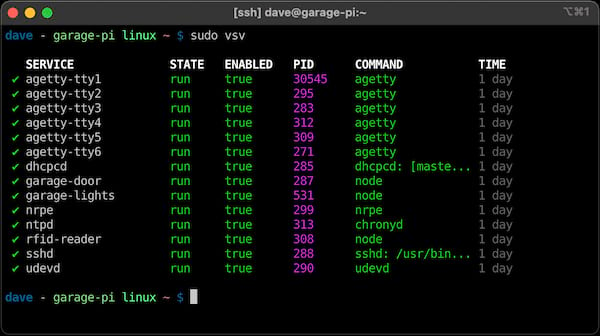
Note: sudo or escalated privileges are required to determine service state
because of the strict permissions on each service's supervise directory.
vsv scans the /var/service directory by default, which can be overridden by
setting the $SVDIR environmental variable or passing in a -d <dir> argument.
Any service that has been in a state for less than 5 seconds will be marked
in red and any less than 30 seconds will be marked in yellow, making new or
failing services easy to spot:
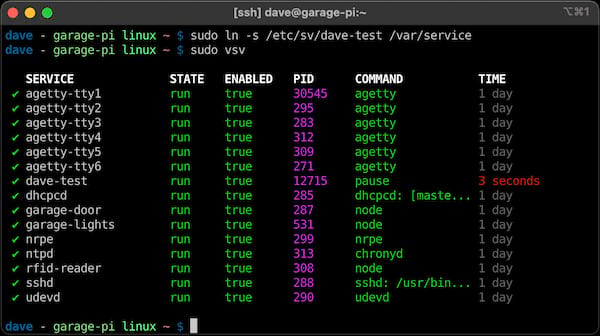
We can isolate the service by passing it as a "filter" to status.

A string can be passed as the first argument after status to filter for
services that contain that string in their name. Also, -t can be supplied to
status to print the process tree of the pid for that process:
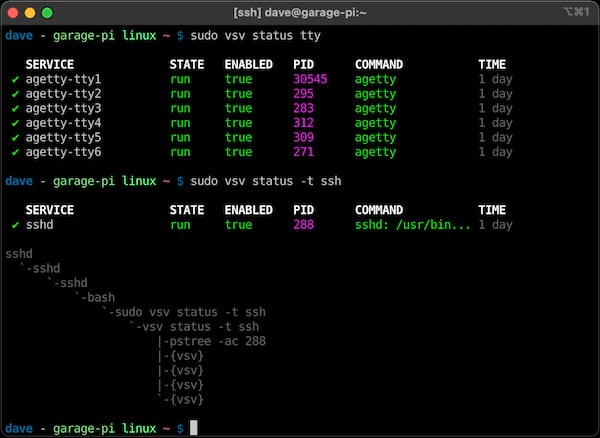
Any command other than status will be passed directly to the sv command.
Restarting a service is as easy as vsv restart <svc>:
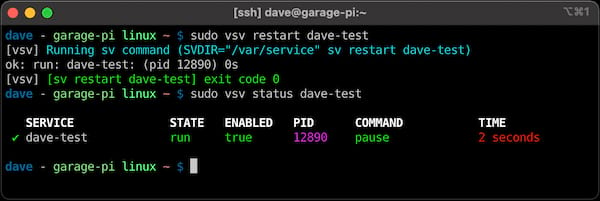
To stop a service, vsv down <svc> or vsv stop <svc> can be used:
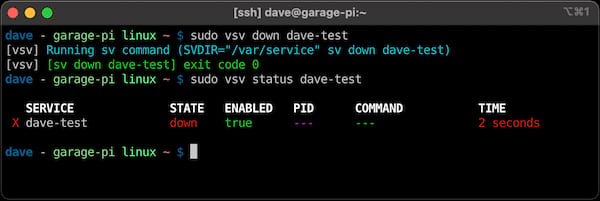
A full service tree can be generated with vsv -t. This command is equivalent
to running vsv status -t:
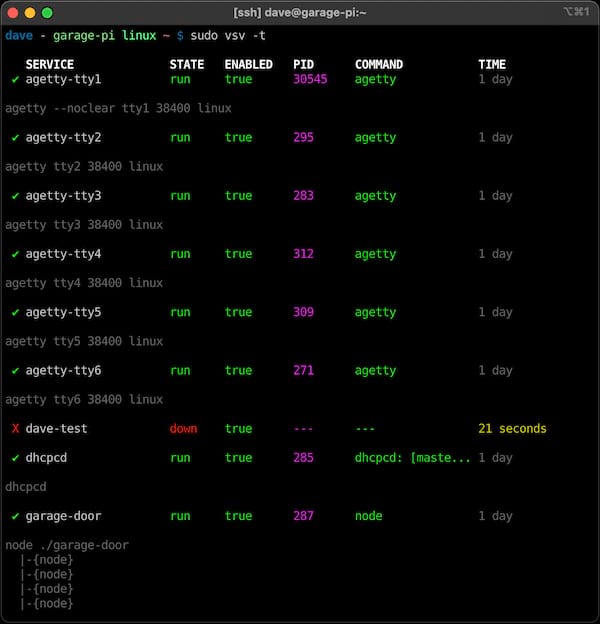
-l can be specified to view log services for each service as well. This
command is equivalent to running vsv status -l virt:
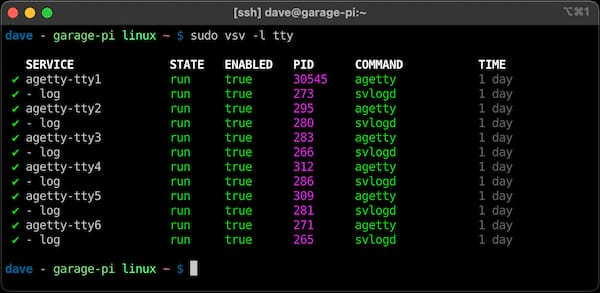
-t can be specified with -l to view log services as a tree for each service
as well as normal services. This command is equivalent to running vsv status -tl virt:
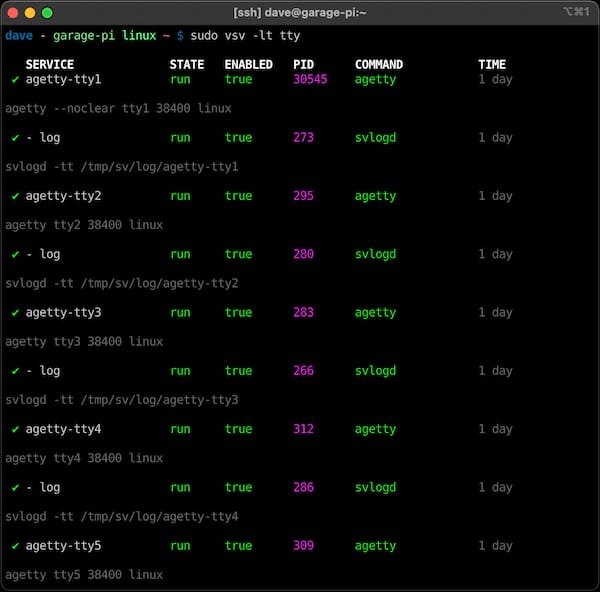
Usage
Quick Examples:
vsv- show all servicesvsv status- same as abovevsv stop <svc>- stop a servicevsv start <svc>- start a servicevsv restart <svc>- restart a servicevsv enable <svc>- enable a service (autostart at boot)vsv disable <svc>- disable a service (no autostart at boot)vsv hup <svc>- refresh a service (SIGHUP)
Status:
The status subcommand has the following fields:
SERVICE- the service (directory) name.STATE- the service state: output from.../$service/supervise/stat.ENABLED- if the service is enabled (lacks the.../$service/downfile).PID- the pid of the process being monitored.COMMAND- arg0 from the pid being monitored (first field of/proc/$pid/cmdline.TIME- time the service has been in whatever state it is in.
Command Usage:
$ vsv -h
__ _______ __
\ \ / / __\ \ / / Void Service Manager
\ V /\__ \\ V / Source: https://github.com/bahamas10/vsv
\_/ |___/ \_/ MIT License
-------------
Manage and view runit services
Made specifically for Void Linux but should work anywhere
Author: Dave Eddy <dave@daveeddy.com> (bahamas10)
vsv 2.0.0
Runit service manager CLI
USAGE:
vsv [OPTIONS] [SUBCOMMAND]
OPTIONS:
-c, --color <yes|no|auto> Enable or disable color output
-d, --dir <dir> Directory to look into, defaults to env SVDIR or /var/service if
unset
-h, --help Print help information
-l, --log Show log processes, this is a shortcut for `status -l`
-t, --tree Tree view, this is a shortcut for `status -t`
-u, --user User mode, this is a shortcut for `-d ~/runit/service`
-v, --verbose Increase Verbosity
-V, --version Print version information
SUBCOMMANDS:
disable Disable service(s)
enable Enable service(s)
help Print this message or the help of the given subcommand(s)
status Show process status
Any other subcommand gets passed directly to the 'sv' command, see sv(1) for
the full list of subcommands and information about what each does specifically.
Common subcommands:
start <service> Start the service
stop <service> Stop the service
restart <service> Restart the service
reload <service> Reload the service (send SIGHUP)
Environmental Variables:
SVDIR: The directory to use, passed to thesvcommand, can be overridden with-d <dir>.PROC_DIR: A Linux procfs directory to use for command name lookups, defaults to/proc.SV_PROG: The command to use for any "external" subcommand given tovsv, defaults tosv.PSTREE_PROG: The command to use to get a process tree for a given pid, defaults topstree.NO_COLOR: Set this environmental variable to disable color output.
Syntax
All source code should be clean of cargo clippy and cargo fmt. You can use
make to ensure this:
$ make check
cargo check
Finished dev [unoptimized + debuginfo] target(s) in 0.01s
cargo clippy
Finished dev [unoptimized + debuginfo] target(s) in 0.12s
$ make fmt
cargo fmt
License
MIT License
Dependencies
~5MB
~96K SLoC